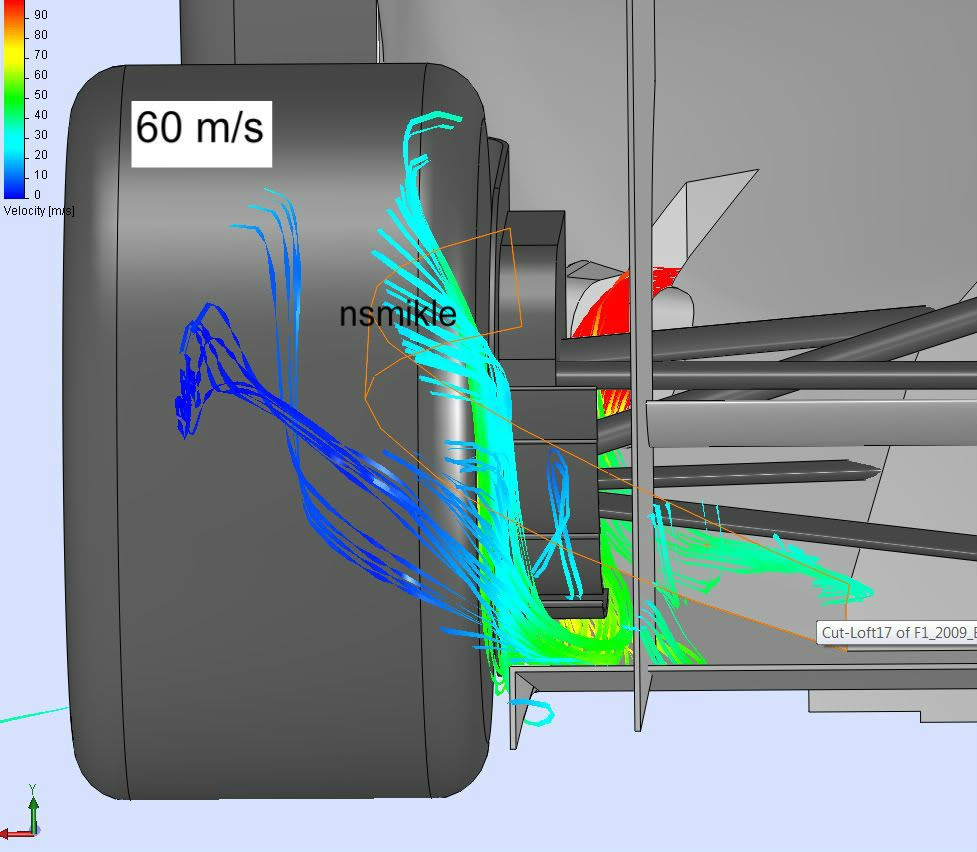Looking again at smikle's CFD, I'm really surprised at how effectively the system works. It's nice to be proven right for once.
- Login or Register
No account yet? Sign up
Well, I was thrown into the ringer earlier for saying that was part of the design, but I believe it's a very important element of their concept. I think the fact that the exhaust hits the floor and then disperses around the tire fairly evenly is the key. Also, the exhaust isn't right up against the tires like last year.TBone wrote:1. If the exhaust is deflected more at low speed does this mean that the exhaust flow hits the rear tyres (and hence heats them) more at slow speeds? If so, then presumably this is a real advantage when preparing for qualifying runs, race start and even in getting traction out of low speed corners? If this is the case then might this not present overheating issues during extended safety car periods?
It was suggested last year (and raised by me and then poo-pooed by others) that RedBull were using an exhaust strategy to heat the tyres for qualifying and the first lap of the race. It would seem that this strategy is open to McLaren if the analysis presented here is representative of the flow that McLaren have attained on the car.TBone wrote:This is fascinating stuff - afraid I'm rather new to this so please excuse the lack of understanding but I have the following questions:
1. If the exhaust is deflected more at low speed does this mean that the exhaust flow hits the rear tyres (and hence heats them) more at slow speeds? If so, then presumably this is a real advantage when preparing for qualifying runs, race start and even in getting traction out of low speed corners? If this is the case then might this not present overheating issues during extended safety car periods?
I don't quite get that. Not that I'm doubting you; I'm just a bit foggy-brained about it.shelly wrote:@pup: interation of exhausts and footplate vortices is not about mitigation, but about incrasing the intensity of the vortices, and at the same time sweeping away tyre squirt.
Oddly enough, that makes sense to me.shelly wrote:The lower part of the tyre has a wake that starts from the contact patch and grows wider towards the back. If you blow in proximity of the side of the tyre at high speed you will make the expansion angle of ths wake smaller.
So slow air fom the tyre wake won't interfere with the diffuser footplate, an more air will come from the top of it (where the temp sticker was spotted on mp4-27) and will curl around its edge, forming a vortex.
If you manage to accelerate this vortex along its axis, it will be narrower too, so it will have lower pressure, i.e. downforce, collected by the footplate itself. The upwash inside the diffuser could also be exploited.
Maybe word explaination is obscure, please tell me if so.


Also, the effect is much weaker than last years. You can see how much the exhaust has spread out and slowed down. My guess it might only be a few tenths of gain rather than that honking 2 seconds that the EBD was giving last year.Crucial_Xtreme wrote:The exhaust is less effective at getting to the floor at higher speeds. The pictures of the CFD sim show more flow spilling over the foot step and getting under the floor which says to me it's current configuration is definitely helping in the low-medium speed corners. Question is if there's less exhaust getting to the floor at higher speeds how is the car recovering the df compared to what it has at a lower speed??
**Edited for grammar
